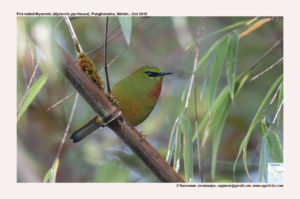
Fire-tailed Myzornis Myzornis pyrrhoura
Etymology:
- Myzornis: Greek word muzao-to suck; ornis -bird.
- Pyrrhoura: Greek word purrhos – flame-coloured, red ; oura – tail.
Vernacular Name: Lepcha: Lho-sagvit-pho
Distribution in India: Resident of Himalayas in India.
Description: Size of 11–13 cm; Wt. of 10–13 g. It is a bright green species with black mask and
crown scalloping, red flash in black-and-white wing, red-sided tail, and rather long, thin, slightly
decurved black bill. The male has crown and entire upperparts as bright green, brightest around
narrow black mask from bill base to behind eye. The crown has rounded black feather centres
(creating scalloped effect); underparts a shade paler, with dull soft-edged reddish triangle from mid-
throat to upper breast, pale blue wash on lower breast and belly, deep orange-buff lower belly and
vent; primary coverts tipped white, upperwing black with white tips, but outer primaries fringed
dark blue basally, white distally, inner primaries and secondaries fringed red basally and shading
through yellow to white distally, tertials with white inner webs; tail dull dark green with fiery-red
outer fringes and broad black tips; iris dark brown to red; bill black; legs yellowish-brown. Female is
similar to male but duller and less glossy, with narrow black centres on crown feathers, more pale
blue on underparts, breast triangle fainter, vent duller.
Habitat : It is found in mossy juniper and rhododendron scrub, oak-rhododendron forest, bushes, low trees in evergreen forest, and bamboo. In breeding it is found from 2000–3950 m and in non-breeding season comes down to 1600 m.
Food habits: It eats spiders, small flies and other insects. It also eats berries, flower nectar and tree
sap. It regularly visits flowering shrubs and trees for nectar and insects. It is found singly or in small
parties, or in small flocks depending on concentrated food resource and often with other species,
including other small babblers. It forages in bushes and shrubs, sometimes up in trees. It also
searches among moss on branches and tree trunks. It hovers in front of flowers and probes into
them; alights on trunks to drink oozing sap; finds insects behind bark. It occasionally makes
flycatching sallies.
Breeding habits: They breed in Apr–Jun in India and Nepal. The nest is built by both sexes. The nest is a globular structure of moss, lined with flakes of rhododendron bark, above ground and embedded in
existing moss on bank or rock face or moss and lichen on trunk of large juniper. The nestlings fed by
both sexes.